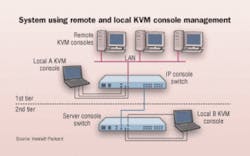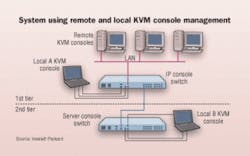As keyboard/video/mouse technology embraces IP, Category 5e cable takes a place at the table.
Keyboard, video, and mouse (KVM) switches have been around for as long as customers have needed access to multiple systems from a single keyboard, mouse, and monitor.
KVM switches actually predate the development of servers, and most definitely predate the development of rack-mounted servers. When servers became more popular, the need to connect or concentrate the connections of many servers down to a smaller number of keyboards, pointing devices, and displays became much more important. To meet the growing number of installed servers, KVM switches began to grow from just single-port to 4- and 8-port switch products, to larger products such as 16-, 32-, 128-, and 256-port models. Today, KVM devices can simultaneously connect many consoles to many servers.
Over the last 10 years, KVM switches have been based on standard switch technologies, and with them came fundamental restrictions. First, the original PS2 keyboard and mouse specification had limited flexibility. The length of the cable that could go between the keyboard and the device was, by definition in the original PS2 specification, limited to a mere 12 feet. What followed were newer KVM technologies expanding cabling setups to approximately 40 feet-but still less than ideal when there is a need, for example, to connect one console to hundreds of servers.
Change is good
Recently, a new class of KVM switches has emerged, which no longer uses the traditional KVM cabling but rather Category 5 UTP. Using Category 5e media as a transport allows longer distances-up to hundreds of feet-and further improves cable management since it can be cut to fit, which reduces cable clutter. In addition, the cable is one-fourth the size of previous cables.
An added and sometimes unexpected benefit of having less cable is that the airflow in a rack-based enclosure improves and, therefore, promotes better cooling.
In parallel to KVM development, remote access to servers-or console management-has been addressed through the server itself. In part, this is due to the advent of such tools as server remote management. These sometimes optional, sometimes integrated cards offer an Internet Protocol (IP)-connected remote server console capability.
The flexibility of IP
As servers began to offer accessories and integrated features that included a remote console over an IP connection, the KVM world responded with its own IP-connected KVM switches. It is important to note that the use of IP offers more flexibility for IT administrators to manage data centers of all sizes through local or network access at speeds comparable to direct console control.
In the server-based model or class of products (as opposed to KVM class), the relationship between the user console and the server is one-to-one. Links are made directly to a single server over an IP connection, and a console session is initiated. These products cater to a customer whose main requirement is server management-the ability to power servers on and off, to manage the health of the server, to manage the actual provisioning of the server, and more.
In contrast, the IP-connected KVM world establishes the connection in a one-to-many relationship. A console connects to a switch, and servers are selected from a list of many available devices. Consequently, a connection is made, unmade, and then remade to new devices. Remote KVM product capabilities are centric to remote console only, not for managing the health of the server but rather for managing applications. Here, the added benefits are fast response times and high performance of the remote console.
In the future, the industry should expect to see a move toward more digital KVM switches that are IP-connected. Over time, as costs are reduced, the industry may even shift from a KVM approach to a remote-console approach, and finally to an integrated-server approach. The latter would take place via simple access to a remote console feature on a server via a direct IP connection.
As has happened in the past with many other technologies, the integration of KVM functionality will continue to push down into the server itself, and will be fully realized when integration costs are low enough to make those features ubiquitous on all servers. At that point, the customer’s needs regarding classic digital or analog KVM switches will diminish, because it can be successfully met with an integrated approach.
Until then, KVM switches are changing by leaps and bounds, offering users an inexpensive and high-performance remote-console solution.
DAVID CHETHAM-STRODE is with Hewlett-Packard Company (www.hp.com).

